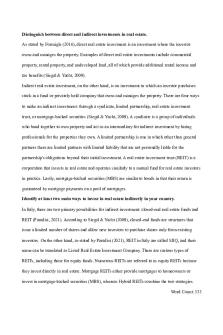HDE 100A - journal 8 PDF

| Title | HDE 100A - journal 8 |
|---|---|
| Course | Infancy and Early Childhood |
| Institution | University of California Davis |
| Pages | 3 |
| File Size | 72.4 KB |
| File Type | |
| Total Downloads | 50 |
| Total Views | 146 |
Summary
Download HDE 100A - journal 8 PDF
Description
JOURNAL 8
1
Hey friend!
Thanks for reaching out to me. I would be glad to help. Some things to consider are the fact that people have various developmental aspects to themselves, which are biosocial, cognitive, and psychosocial development. Biosocial development regards an individual’s physical development, considering their biological and nutritional growth. Cognitive development refers to a person’s intellectual growth, so it includes their knowledge of language, academic abilities, and level of thought processes. Lastly, psychosocial development is in reference to how an individual’s interaction with their environment influences their development. Thus, psychosocial development includes factors like societal, family, and friend impacts, and it also regards a person’s emotional health (Berger, 2018).
There are some biosocial similarities and differences between a 2 year old and a 6 year old. As children age, their motor skills are continuously developing. Around age 2, most children are able to simply run around. By 6 years old, kids’ motor skills should be more developed, so they should be able to run at a more advanced level (Anistranski, 2019). For example, many 6 year olds do very active sports, like soccer. Children’s fine motor skills also develop across time. At age 2, most children are able to hold objects, like utensils or pencils. By age 6, they are able to do more advanced tasks when using their hands (Anistranski, 2019). For example, on top of being able to hold a pencil, like at age 2, a 6 year old is able to also write the alphabet with a pencil.
There are also some cognitive aspects to development. By age 2, children generally say short
JOURNAL 8
2
sentences, averaging 2 to 6 words a sentence, and they often ask questions like “what’s that?” By age 6, kids still form sentences and ask questions, but they do so at a more advanced level. When saying sentences, children often seem to have unending sentences, since they often form run-on sentences. Additionally, 6 year olds ask more about social differences (Berger, 2018). For example, they may ask about the disparity between males and females or older and younger people.
Lastly, there are some psychosocial factors to human development. Both the 2 year old and 6 year old will have already developed emotional experiences, like joy and sadness. However, the 6 year old will be able to have more emotional regulation than the 2 year old (Berger, 2018).
If you have any further questions, feel free to contact me again.
Take care,
Megan Andya
JOURNAL 8
3
References Anistranski, J. (2019). Biosocial Development from 3-6 [Prezi]. Retrieved from https://prezi.com/qxxhmqhtctvd/biosocial-development-from-3-6/?utm_campaign=share &utm_medium=copy Anistranski, J. (2019). Birth to Two: Biosocial Development [Prezi]. Retrieved from https://prezi.com/p4lo1hq-fg9w/birth-to-two-biosocial-development/?utm_campaign=sha re&utm_medium=copy Berger, K.S. (2018). Developing Person Through Childhood and Adolescence. New York: Worth Publishers....
Similar Free PDFs

HDE 100A - journal 8
- 3 Pages

HDE Handelsreport Lebensmittel 2020
- 20 Pages

HDE Final Study Guide
- 38 Pages

Journal 8:1 Refliection
- 2 Pages

Learning Journal Unit 8
- 2 Pages

Learning Journal Unit 8
- 2 Pages

Unit 8 journal - 105
- 3 Pages

BUS2204 - Learning Journal 8
- 2 Pages

CAS 100A Study Guide
- 3 Pages

LJ8 - Learning journal unit 8
- 1 Pages

Learning Journal Unit 8.pdf
- 1 Pages

Syllabus Winter 2018 100A
- 6 Pages

LJ8 learning journal unit 8
- 2 Pages

Isf 100A Part I and II
- 17 Pages

BUS 2202 Learning Journal Unit 8
- 1 Pages
Popular Institutions
- Tinajero National High School - Annex
- Politeknik Caltex Riau
- Yokohama City University
- SGT University
- University of Al-Qadisiyah
- Divine Word College of Vigan
- Techniek College Rotterdam
- Universidade de Santiago
- Universiti Teknologi MARA Cawangan Johor Kampus Pasir Gudang
- Poltekkes Kemenkes Yogyakarta
- Baguio City National High School
- Colegio san marcos
- preparatoria uno
- Centro de Bachillerato Tecnológico Industrial y de Servicios No. 107
- Dalian Maritime University
- Quang Trung Secondary School
- Colegio Tecnológico en Informática
- Corporación Regional de Educación Superior
- Grupo CEDVA
- Dar Al Uloom University
- Centro de Estudios Preuniversitarios de la Universidad Nacional de Ingeniería
- 上智大学
- Aakash International School, Nuna Majara
- San Felipe Neri Catholic School
- Kang Chiao International School - New Taipei City
- Misamis Occidental National High School
- Institución Educativa Escuela Normal Juan Ladrilleros
- Kolehiyo ng Pantukan
- Batanes State College
- Instituto Continental
- Sekolah Menengah Kejuruan Kesehatan Kaltara (Tarakan)
- Colegio de La Inmaculada Concepcion - Cebu
